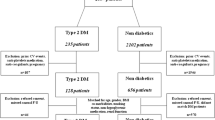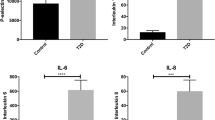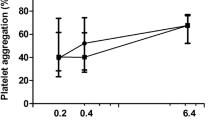Abstract
Background
The metabolic syndrome is a matter of ongoing debate with regard to its existence, classification, clinical meaningfulness, and associated risks for vessel occlusion. Considering that persistent platelet activation is a cornerstone for the development of acute vascular events, and that patients with type 2 diabetes consistently exhibit high platelet activity, these characteristics may be critical for distinguishing and triageing specific features of metabolic syndrome among established risk factors for vascular disease.
Methods
We assessed the platelet activity by conventional aggregation, expression of major surface receptors by flow cytometry, and quantitatively by rapid bedside analyzers in 20 aspirin-naïve patients with documented metabolic syndrome, and compared these with 20 untreated subjects with multiple cardiovascular risk factors.
Results
Closure time by the PFA-100 analyzer was significantly (P = 0.002) shorter in patients with metabolic syndrome indicating platelet inhibition under high shear conditions. Ultegra analyzer readings revealed increased fibrinogen binding (P = 0.0003) what in combination with the increased expression of PAC-1 (P = 0.32) strongly suggest activation of platelet glycoprotein IIb/IIIa receptor. Surface expression of CD107a (P = 0.014), and SPAN-12 (P = 0.003) were also higher in patients with metabolic syndrome. In contrast, platelet aggregation induced by collagen or ADP, CD31, CD41, CD42b, CD51/61, CD62p, CD63, CD154, CD165, so as formation of platelet-monocyte aggregates, PAR-1 thrombin receptor, and thrombospondin did not differ between groups.
Conclusion
Patients with metabolic syndrome exhibited a higher degree of platelet activation than subjects with conventional risk factors for vascular disease. Conceptually, applying adequate antiplatelet strategies may reduce the risk of acute thrombotic events in these patients. Further prospective studies exploring this notion are encouraged.
Similar content being viewed by others
References
American Heart Association (2002) Heart disease and stroke statistics—2003 update. American Heart Association, Dallas, Texas
European Cardiovascular Disease Statistics (2000) Edition, British Heart Foundation
Chockalingam A, Balaguer-Vintro I (1999) Impending global pandemic of cardiovascular diseases. Prous Science, Barcelona, Spain
Hennekens CH (1998) Increasing burden of cardiovascular disease: current knowledge and future directions for research on risk factors. Circulation 97:1095–1102
Fuster V, Badimon L, Badimon JJ et al (1992) The pathogenesis of coronary disease and the acute coronary syndromes. N Engl J Med 326(4):242–250
Fitzgerald DJ, Roy L, Catella F, Fitzgerald GA (1986) Platelet activation in unstable coronary disease. N Engl J Med 315(16):983–989
ISIS-2 (Second International Study of Infarct Survival Collaborative Group) (1988) Randomised trial of intravenous streptokinase, aspirin, both, or neither among 17,187 cases of suspected acute myocardial infarction: ISIS-2. Lancet 2(8609):349–360
Hass WK, Easton JD, Adams HP et al (1989) A randomized trial comparing ticlopidine hydrochloride with aspirin for the prevention of stroke in high-risk patients. Ticlopidine Aspirin Stroke Study Group. N Engl J Med 321(8):501–507
Caprie Steering Committee (1996) A randomised, blinded, trial of clopidogrel versus aspirin in patients at risk of ischemic events (CAPRIE). Lancet 348(9038):1329–1339
Shaw LJ, Berman DS, Hendel RC, Alazraki N, Krawczynska E, Borges-Neto S, Maddahi J, Cerqueira M (2006) Cardiovascular disease risk stratification with stress single-photon emission computed tomography technetium-99m tetrofosmin imaging in patients with the metabolic syndrome and diabetes mellitus. Am J Cardiol 97:1538–1544
Ovbiagele B, Saver JL, Lynn MJ, Chimowitz M, WASID Study Group (2006) Impact of metabolic syndrome on prognosis of symptomatic intracranial atherostenosis. Neurology 66:1344–1349
Anfossi G, Russo I, Massucco P, Mattiello L, Doronzo G, De Salve A, Trovati M (2004) Impaired synthesis and action of antiaggregating cyclic nucleotides in platelets from obese subjects: possible role in platelet hyperactivation in obesity. Eur J Clin Invest 34:482–489
Arteaga RB, Chirinos JA, Soriano AO, Jy W, Horstman L, Jimenez JJ, Mendez A, Ferreira A, de Marchena E, Ahn YS (2006) Endothelial microparticles and platelet and leukocyte activation in patients with the metabolic syndrome. Am J Cardiol 98:70–74
Morita H, Ikeda H, Haramaki N, Eguchi H, Imaizumi T (2005) Only two-week smoking cessation improves platelet aggregability and intraplatelet redox imbalance of long-term smokers. J Am Coll Cardiol 45:589–594
Lilienberg G, Venge P (1998) Platelet adhesion in patients prone to arterial and venous thrombosis: the impact of gender, smoking and heredity. Scand J Clin Lab Invest 58:279–286
Third report of the National Cholesterol Education Program (NCEP) expert panel on detection, evaluation, and treatment of high blood cholesterol in adults (Adult Treatment Panel III) (2002) Final report. Circulation 106:3143–3421
Grundy SM, Brewer HB Jr, Cleeman JI et al (2004) Definition of metabolic syndrome. Report of the National heart, lung, and blood institute /American heart association conference on scientific issues related to definition Circulation 109:433–438
Ruggeri ZM (1994) New insights into the mechanisms of platelet adhesion and aggregation. Semin Hematol 31:229–239
Mammen EF, Comp PC, Gosselin R et al (1998) PFA-100 system: a new method for assessment of platelet dysfunction. Semin Thromb Hemost 24:195–202
Smith JW, Steinhubl SR, Lincoff AM et al (1999) Rapid platelet-function assay. An automated and quantitative cartridge-based method. Circulation 99:620–625
Ault KA (1993) Flow cytometric measurement of platelet function and reticulated platelets. Ann NY Acad Sci 677:293–308
Anfossi G, Russo I, Massucco P, Mattiello L, Trovati M (2003) Platelet resistance to the antiaggregating effect of N-acetyl-L-cysteine in obese, insulin-resistant subjects. Thromb Res 110:39–46
Esposito K, Marfella R, Ciotola M, Di Palo C, Giugliano F, Giugliano G, D’Armiento M, D’Andrea F, Giugliano D (2004) Effect of a mediterranean-style diet on endothelial dysfunction and markers of vascular inflammation in the metabolic syndrome: a randomized trial. JAMA 292:1440–1446
Arruzazabala ML, Molina V, Mas R, Fernandez L, Carbajal D, Valdes S, Castano G (2002) Antiplatelet effects of policosanol (20 and 40 mg/day) in healthy volunteers and dyslipidaemic patients. Clin Exp Pharmacol Physiol 29:891–897
Serebruany VL, Pokov AN, Malinin AI, O’Connor C, Bhatt DL, Tanguay JF, Sane DC, Hennekens CH (2006) Valsartan inhibits platelet activity at different doses in mild to moderate hypertensives: valsartan inhibits platelets (VIP) trial. Am Heart J 151:92–99
Jesri A, Okonofua EC, Egan BM (2005) Platelet and white blood cell counts are elevated in patients with the metabolic syndrome. J Clin Hypertens 7:705–711
Nieuwdorp M, Stroes ES, Meijers JC, Buller H (2005) Hypercoagulability in the metabolic syndrome. Curr Opin Pharmacol 5:155–159
Trost S, Pratley R, Sobel B (2006) Impaired fibrinolysis and risk for cardiovascular disease in the metabolic syndrome and type 2 diabetes. Curr Diab Rep 6:47–54
Abaci A, Yilmaz Y, Caliskan M, Bayram F, Cetin M, Unal A, Cetin S (2005) Related articles, links abstract effect of increasing doses of aspirin on platelet function as measured by PFA-100 in patients with diabetes. Thromb Res 116:465–470
Mehta SS, Silver RJ, Aaronson A, Abrahamson M, Goldfine AB (2006) Comparison of aspirin resistance in type 1 versus type 2 diabetes mellitus. Am J Cardiol 97:567–570
Lev EI, Patel RT, Maresh KJ, Guthikonda S, Granada J, DeLao T, Bray PF, Kleiman NS (2006) Related articles, links abstract aspirin and clopidogrel drug response in patients undergoing percutaneous coronary intervention: the role of dual drug resistance. J Am Coll Cardiol 47:27–33
Angiolillo DJ, Fernandez-Ortiz A, Bernardo E, Ramirez C, Sabate M, Jimenez-Quevedo P, Hernandez R, Moreno R, Escaned J, Alfonso F, Banuelos C, Costa MA, Bass TA, Macaya C (2005) Platelet function profiles in patients with type 2 diabetes and coronary artery disease on combined aspirin and clopidogrel treatment. Diabetes 54:2430–2435
Suni MA, Maino VC, Maecker HT (2005) Ex vivo analysis of T-cell function. Curr Opin Immunol 17:434–440
Shoelson SE, Lee J, Goldfine AB (2006) Inflammation and insulin resistance. J Clin Invest 116:1793–1801
Serebruany VL, Miller M, Pokov AN, Malinin AI, Lowry DR, Tanguay J-F, Hennekens CH (2006) Statins inhibit platelet PAR-1 thrombin receptor in patients with metabolic syndrome: the PAR-1 inhibition by statins (PARIS) study. Am J Cardiol 97:1332–1336
Acknowledgements
The authors thank all the nurses and laboratory personnel for their technical excellence and outstanding effort in this study. The study was supported in part by a grant from H. Lundbeck A/S, Copenhagen Valby, Denmark, and HeartDrug Research LLC, Wilmington, DE, USA. DA is supported by grants from the the National Association of Norway for Public Health—the Norwegian Council for Heart and Vessels; the Eastern Regional Health Authority of Norway; and the Aker University Hospital Research Foundation.
Author information
Authors and Affiliations
Corresponding author
Rights and permissions
About this article
Cite this article
Serebruany, V.L., Malinin, A., Ong, S. et al. Patients with metabolic syndrome exhibit higher platelet activity than those with conventional risk factors for vascular disease. J Thromb Thrombolysis 25, 207–213 (2008). https://doi.org/10.1007/s11239-007-0047-3
Received:
Accepted:
Published:
Issue Date:
DOI: https://doi.org/10.1007/s11239-007-0047-3




